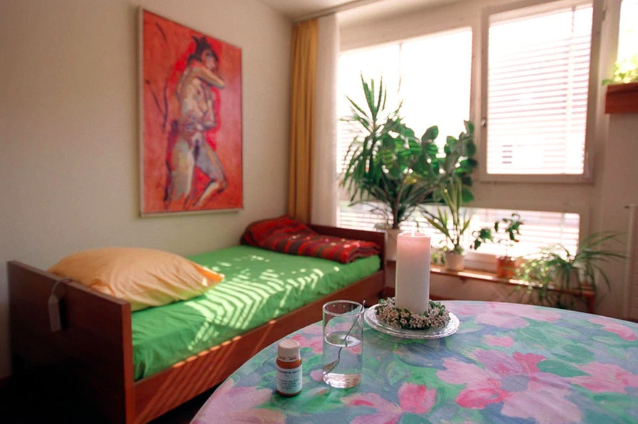الخميس, أبريل 13th 2023

Traveling to Switzerland may conjure up images of skiing the Alps and sitting fireside with a pot of fondue; but for about 1,300 tourists a year, Switzerland is synonymous with death. The country’s “suicide tourism” has long been considered controversial to outsiders, but the locals overwhelmingly support a patient’s right to choose how their life ends.
At the beginning of the 20ال century, Switzerland decriminalized suicide and then went a step further in 1941 by legalizing assisted death so long as it is performed by a “non-physician without a vested interest in that individual’s death.” Switzerland is unique in that patients administer the lethal doses to themselves.
Assisted death is legal in a few other countries, including Canada, the Netherlands, Belgium, Luxembourg and Spain, but the ability to obtain one varies greatly from country to country. Switzerland is rare in that it supports “suicide tourism,” meaning it allows patients living in countries where assisted suicide is illegal to end their lives in Switzerland.
Technically, patients do not have to be terminally ill, but they do have to possess their decision-making capabilities. (In 2011, Switzerland officials announced their intention to change the law “to make sure it was used only as a last resort by the terminally ill,” but that has yet to pass). The company which facilitates the majority of suicides in Switzerland – Dignitas – requires patients to provide proof from a physician specifying a terminal illness.

The Alpine nation is one of the only places in the world where terminally ill patients with more than six months to live can choose suicide – which is why New York Times’ bestselling author Amy Bloom and her husband came to Switzerland in January 2020. Just 48 hours after being diagnosed with Alzheimer’s disease at the age of 67, her husband, architect Brian Ameche, said he would like to die on his own terms. Bloom spoke with me about their decision.
“I believe that there are a number of circumstances in which it is important that a person with judgement and the intellectual capacity should be allowed to make the decision to end their life painlessly and comfortably,” Bloom said.
Brian had already begun his descent into dementia by the time he was diagnosed. Bloom says he was staring down years of mental and physical decline, as well as financial and emotional strain on those around him. She says his decision to “leave early” was “100% who he was.”
“Switzerland was our best and only choice,” Bloom said. They traveled to Zurich in early 2020 and checked into a Dignitas apartment on the outskirts of the city. The staff provided Brian with a lethal dose of sodium pentobarbital and when he was ready, he drank it.
“I sit, holding his hand for a long time. I get up and wrap my arms around him and kiss his forehead, as if he is my baby, at last gone to sleep, as if he is my brave boy going on a long journey, miles and miles of Nought,” Bloom writes in her new memoir In Love: A Memoir of Love and Loss.
“My wish would be that it would be more possible to arrange your own painless, legal death in the face of a terminal illness, even if the termination point of the illness is many years out,” Bloom said.

Even if the death occurs in Switzerland, people who travel with the patient must abide by the laws of their country of origin. For example, U.K. citizens can face up to 14 years in prison if they do anything that could be construed as “encouraging or assisting” another person to die. So, if the spouse of a patient buys their plane ticket, pushes their wheelchair through the airport or even talks on the record about suicide preparations, this can be construed as “assisting” in another person’s death.
Therefore, an officer and a photographer in Switzerland must document the death right after it has occurred. In addition, Dignitas apartments can be equipped with video cameras to provide evidence that the suicide was not assisted in any way. When family or friends of the patient return to their home, they must report the death to the authorities.
In 2011, Zürich legislators proposed a ban on “suicide tourism” to prevent outsiders from using the services. For reference, more than 90% of Dignitas’ clients come from outside of Switzerland, the organization reports. The suicide tourism ban was rejected by voters with a nearly 80% majority. Swiss citizens spoke out against the ban so vehemently, that the Swiss government later that year decided against introducing new regulations on assisted death.
A 2020 study of Switzerland’s attitude toward suicide found that 82% supported it and 61% would consider it for themselves under certain circumstances. Moreover, nearly 30% were already members of some sort of “right-to-die” advocacy group.
Still, the European Court of Human Rights has reprimanded Switzerland for its lack of legal clarity surrounding suicide. The more controversial cases involve applicants who were not suffering from a terminal illness, but did have mental conditions such as depression. Most Swiss doctors report not being willing to issue prescriptions for lethal medications in such cases.

Patients may have another, more modern option to choose from by the end of 2022, according to technology company Exit. The Australian company 3D prints futuristic capsules, called “Sarco,” so that patients can die in any setting they choose.
In order to use one of the suicide pods, someone must get inside and answer a number of questions. If they pass those tests, the patient may then press a button which floods the interior with nitrogen. Oxygen levels drop from 21% down to 1% in 30 seconds. The patient will feel light-headed before losing consciousness and dying painlessly about 5 to 10 minutes later, according to company founder Philip Nitschke. There is also an emergency button to exit.
And while the Sarco pods do not break any existing Swiss laws, lawyers say the use of nitrogen means that the pods do not adhere to the Swiss definition of a medical device and therefore are not covered by law. Still, Exit’s Nitschke announced in 2021 that he plans to make the blueprints available for free so that anyone with a 3D printer could create one in hopes to “de-medicalize the dying process.”
يمكن مشاركة هذه المقالة وإعادة نشرها على مواقع إلكترونية أخرى دون إذن منا، طالما أنها ترتبط بصفحة UltraSwiss الأصلية.
